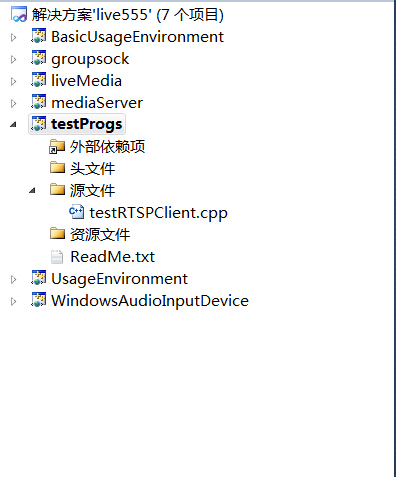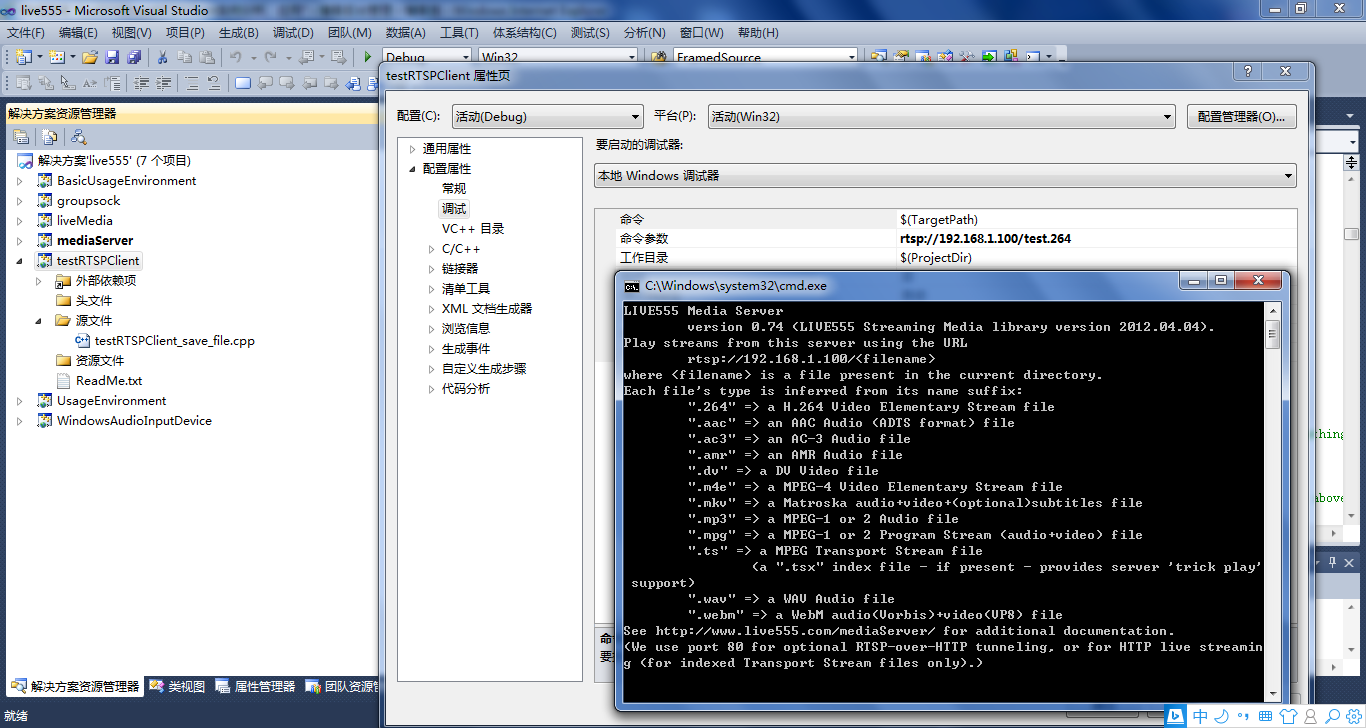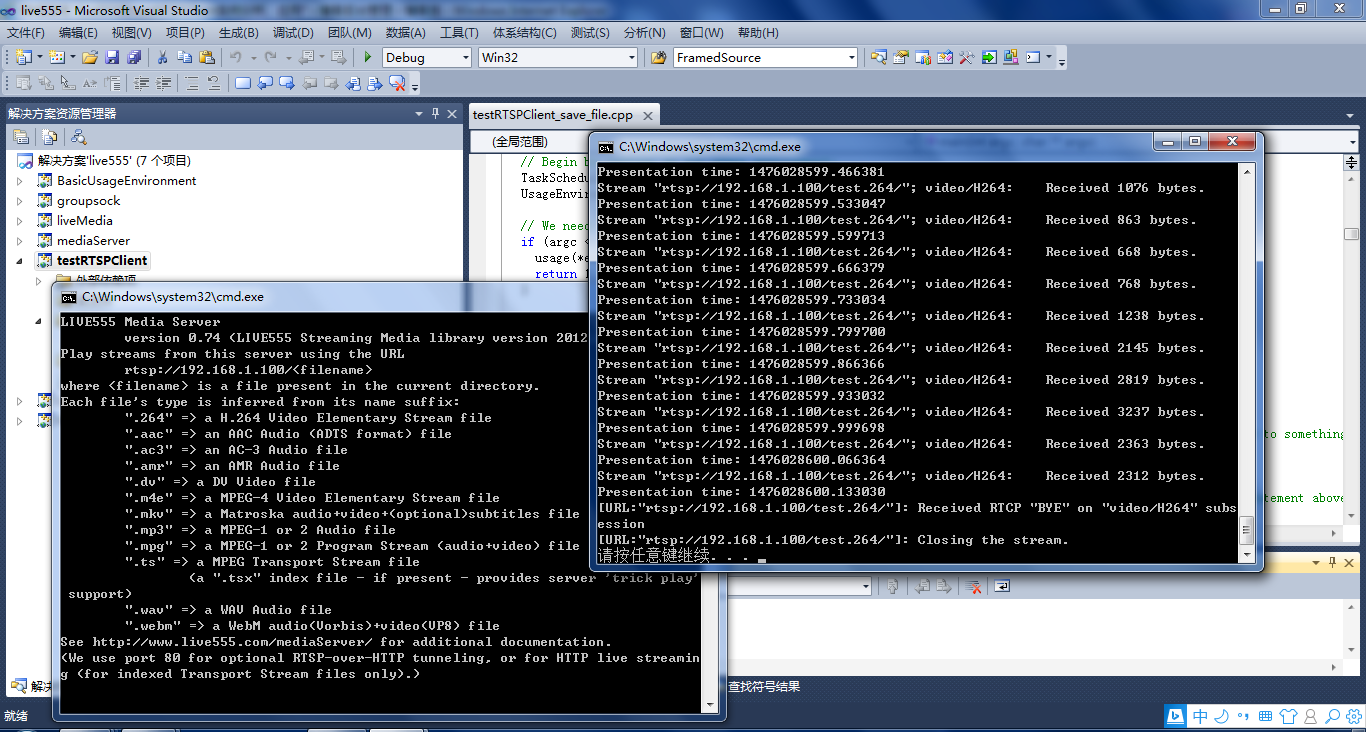live555库中的testRTSPClient实例
1、testRTSPClient简介
testRTSPClient是个简单的客户端实例,这个实例对rtsp数据交互作了详细的描述,其中涉及到rtsp会话的两个概念Source和Sink.
Source是生产数据,Sink是消费数据.
testRTSPClient非常简洁,除了接收服务端发送过来的数据,什么都没干,所以我们很方便在这个基础上改造,做我们自己的项目.
2、testRTSPClient编译,运行
在linux下编译运行更方便,鉴于我的电脑太渣,虚拟机跑起来费劲,就转到windows下来折腾.
在windows下只需要加载这一个文件就可以编译,我们以mediaServer为服务端,以testRTSPClient为客户端。
当然也可以用支持rtsp协议的摄像机或其他实体设备作为服务端。


先启动mediaServer,然后在testRTSPClient项目的命令菜单里填入mediaServer 提示的IP, 再启动testRTSPClient即可。


3、testRTSPClient核心代码解读
1)看代码之前可以大致浏览一下总体的框架,这位博主画了个流程图http://blog.csdn.net/smilestone_322/article/details/17297817
void DummySink::afterGettingFrame(unsigned frameSize, unsigned numTruncatedBytes,
struct timeval presentationTime, unsigned /*durationInMicroseconds*/) {
// We've just received a frame of data. (Optionally) print out information about it:
#ifdef DEBUG_PRINT_EACH_RECEIVED_FRAME
if (fStreamId != NULL) envir() << "Stream \"" << fStreamId << "\"; ";
envir() << fSubsession.mediumName() << "/" << fSubsession.codecName() << ":\tReceived " << frameSize << " bytes";
if (numTruncatedBytes > 0) envir() << " (with " << numTruncatedBytes << " bytes truncated)";
char uSecsStr[6+1]; // used to output the 'microseconds' part of the presentation time
sprintf(uSecsStr, "%06u", (unsigned)presentationTime.tv_usec);
envir() << ".\tPresentation time: " << (unsigned)presentationTime.tv_sec << "." << uSecsStr;
if (fSubsession.rtpSource() != NULL && !fSubsession.rtpSource()->hasBeenSynchronizedUsingRTCP()) {
envir() << "!"; // mark the debugging output to indicate that this presentation time is not RTCP-synchronized
}
envir() << "\n";
#endif // Then continue, to request the next frame of data:
continuePlaying();
} Boolean DummySink::continuePlaying() {
if (fSource == NULL) return False; // sanity check (should not happen) // Request the next frame of data from our input source. "afterGettingFrame()" will get called later, when it arrives:
fSource->getNextFrame(fReceiveBuffer, DUMMY_SINK_RECEIVE_BUFFER_SIZE,
afterGettingFrame, this,
onSourceClosure, this);
return True;
}
2)有网友在testRTSPClient基础上,把接收的数据写成h264文件了http://blog.csdn.net/occupy8/article/details/36426821
void DummySink::afterGettingFrame(void* clientData, unsigned frameSize, unsigned numTruncatedBytes,
struct timeval presentationTime, unsigned durationInMicroseconds) {
DummySink* sink = (DummySink*)clientData;
sink->afterGettingFrame(frameSize, numTruncatedBytes, presentationTime, durationInMicroseconds);
} // If you don't want to see debugging output for each received frame, then comment out the following line:
#define DEBUG_PRINT_EACH_RECEIVED_FRAME 1 void DummySink::afterGettingFrame(unsigned frameSize, unsigned numTruncatedBytes,
struct timeval presentationTime, unsigned /*durationInMicroseconds*/) {
// We've just received a frame of data. (Optionally) print out information about it:
#ifdef DEBUG_PRINT_EACH_RECEIVED_FRAME
if (fStreamId != NULL) envir() << "Stream \"" << fStreamId << "\"; ";
envir() << fSubsession.mediumName() << "/" << fSubsession.codecName() << ":\tReceived " << frameSize << " bytes";
if (numTruncatedBytes > 0) envir() << " (with " << numTruncatedBytes << " bytes truncated)";
char uSecsStr[6+1]; // used to output the 'microseconds' part of the presentation time
sprintf(uSecsStr, "%06u", (unsigned)presentationTime.tv_usec);
envir() << ".\tPresentation time: " << (unsigned)presentationTime.tv_sec << "." << uSecsStr;
if (fSubsession.rtpSource() != NULL && !fSubsession.rtpSource()->hasBeenSynchronizedUsingRTCP()) {
envir() << "!"; // mark the debugging output to indicate that this presentation time is not RTCP-synchronized
}
envir() << "\n";
#endif //todo one frame
//save to file
if(!strcmp(fSubsession.mediumName(), "video"))
{
if(firstFrame)
{
unsigned int num;
SPropRecord *sps = parseSPropParameterSets(fSubsession.fmtp_spropparametersets(), num);
// For H.264 video stream, we use a special sink that insert start_codes:
struct timeval tv= {0,0};
unsigned char start_code[4] = {0x00, 0x00, 0x00, 0x01};
FILE *fp = fopen("test.264", "a+b");
if(fp)
{
fwrite(start_code, 4, 1, fp);
fwrite(sps[0].sPropBytes, sps[0].sPropLength, 1, fp);
fwrite(start_code, 4, 1, fp);
fwrite(sps[1].sPropBytes, sps[1].sPropLength, 1, fp);
fclose(fp);
fp = NULL;
}
delete [] sps;
firstFrame = False;
} char *pbuf = (char *)fReceiveBuffer;
char head[4] = {0x00, 0x00, 0x00, 0x01};
FILE *fp = fopen("test.264", "a+b");
if(fp)
{
fwrite(head, 4, 1, fp);
fwrite(fReceiveBuffer, frameSize, 1, fp);
fclose(fp);
fp = NULL;
}
} // Then continue, to request the next frame of data:
continuePlaying();
} Boolean DummySink::continuePlaying() {
if (fSource == NULL) return False; // sanity check (should not happen) // Request the next frame of data from our input source. "afterGettingFrame()" will get called later, when it arrives:
fSource->getNextFrame(fReceiveBuffer, DUMMY_SINK_RECEIVE_BUFFER_SIZE,
afterGettingFrame, this,
onSourceClosure, this);
return True;
}
testRTSPClient接收的fReceiveBuffer缓存没有起始码,start_code[4] = {0x00, 0x00, 0x00, 0x01}; 写成文件或者播放都需要自行加上。
3)testRTSPClient这个实例还支持多路录放,网上搜到有人已经实现了,搬过来.
http://blog.chinaunix.net/uid-15063109-id-4482932.html
——缺什么补什么
live555库中的testRTSPClient实例的更多相关文章
- RTSP客户端接收存储数据(live555库中的testRTSPClient实例)
1.testRTSPClient简介 testRTSPClient是个简单的客户端实例,这个实例对rtsp数据交互作了详细的描述,其中涉及到rtsp会话的两个概念Source和Sink. Source ...
- live555库中的testH264VideoStreamer实例
1.h264文件的推送 testH264VideoStreamer.cpp文件的开头就定义了 char const* inputFileName = "test.264"; 后面接 ...
- live555库中的openRTSP实例
一.openRTSP编译运行 a)windows下编译运行 还是以mediaServer作为服务端,openRTSP作为客户端 b)Linux下编译运行 转自http://kuafu80.blog.1 ...
- RTSP客户端接收存储数据(live555库中的openRTSP实例)
一.openRTSP编译运行 a)windows下编译运行 还是以mediaServer作为服务端,openRTSP作为客户端 b)Linux下编译运行 转自http://kuafu80.blog.1 ...
- RTSP服务端转发服务(live555库中的testH264VideoStreamer.cpp和testOnDemandRTSPServer.cpp实例)
1.h264文件的推送 testH264VideoStreamer.cpp文件的开头就定义了 char const* inputFileName = "test.264"; 后面接 ...
- 宣布在 Azure 镜像库中正式推出 Windows Server 2012 R2 并降低 Windows Azure 的实例定价
我们今天将宣布两条消息,为使用基础结构服务的客户提供更多选择和成本节约:在镜像库中推出 Windows Server 2012 R2 以及降低 Memory Intensive 计算实例定价. 虚拟机 ...
- NSClassFromString 实例话静态库中的类
Class myClass = NSClassFromString("StaticLibyClassName"); StaticLibyClassName是从静态库中实例化一个Cl ...
- Solr的原理及在项目中的使用实例.
前面已经讲过 如果安装及配置Solr服务器了, 那么现在我们就来正式在代码中使用Solr.1,这里Solr主要是怎么使用的呢? 当我们在前台页面搜索商品名称关键词时, 我们这时是在Solr库中去查找 ...
- linux静态与动态库创建及使用实例
一,gcc基础语法: 基本语法结构:(由以下四部分组成) gcc -o 可执行文件名 依赖文件集(*.c/*.o) 依赖库文件及其头文件集(由-I或-L与-l指明) gcc 依赖文件集(*.c/*.o ...
随机推荐
- 【BZOJ 1014】【JSOI 2008】火星人prefix
看了<Hash在信息学竞赛中的一类应用>中的例题3,这道题很类似啊,只不过没有删点和区间翻转. 用Splay维护字符串哈希,加点改点什么的就不用说了,查询时二分答案,这样时间复杂度是$O( ...
- jquery.ui.widget详解
案例详解 <!DOCTYPE html> <html> <head> <meta charset="UTF-8"> <titl ...
- 【USACO 1.4】Mother's Milk
/* TASK: milk3 LANG: C++ SOLVE: 倒水,dfs,枚举每一种倒法,ca[i][j]记录a和c桶的状态,因为总体积不变,故b的状态不需要记录. */ #include< ...
- 如何在iOS9的plist文件中配置不使用https
App Transport Security has blocked a cleartext HTTP (http://) resource load since it is insecure. Te ...
- golang学习之旅:官方文档汇总
The Go Programming Language Specification:http://localhost:8080/ref/spec学习Constants.Variables.Types. ...
- 【bzoj1001】 BeiJing2006—狼抓兔子
http://www.lydsy.com/JudgeOnline/problem.php?id=1001 (题目链接) 题意 给出一张图,求最小割. Solution1 最小割=最大流,所以直接Din ...
- 拉曼软件在win8上运行出错问题
前提:xp上安装运行都没错 xp的.NET 环境是4.0 ,win8 是64位系统.自带.NET Framework 3 (3.0 3.5) 和.NET Framework 4.51:源程序拷贝到w ...
- 基本概率分布Basic Concept of Probability Distributions 2: Poisson Distribution
PDF version PMF A discrete random variable $X$ is said to have a Poisson distribution with parameter ...
- POJ 1365 Prime Land(数论)
题目链接: 传送门 Prime Land Time Limit: 1000MS Memory Limit: 10000K Description Everybody in the Prime ...
- 使用canvas绘制时钟
使用canvas绘制时钟 什么使canvas呢?HTML5 <canvas> 元素用于图形的绘制,通过脚本 (通常是JavaScript)来完成.<canvas> 标签只是图 ...
